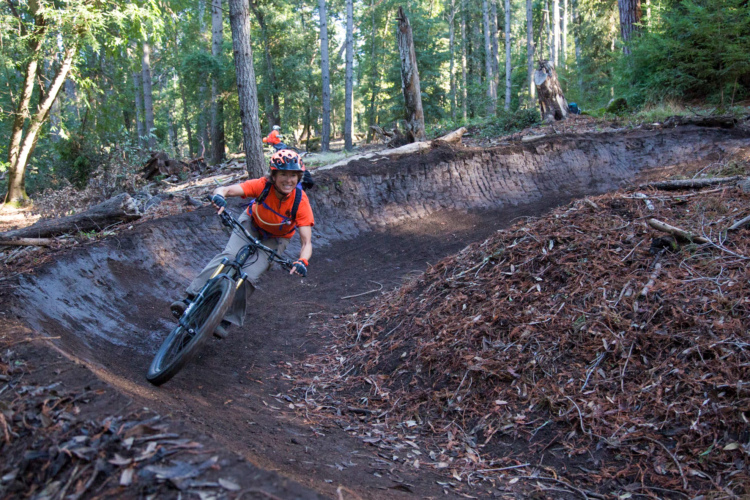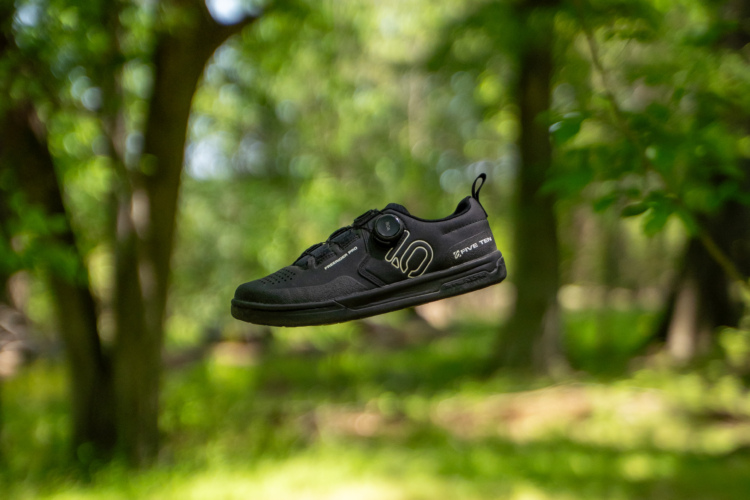
As much as we all like to romanticize the simplicity of cycling, the truth is, there’s a whole bunch of gear that’s necessary for a successful ride. Effectively packing and transporting your kit, shoes, tools, food, fluids, helmet, pads, gloves, eye protection, and any number of little accessories can be an exercise in futility. For the past few years, my race day preparation has involved unceremoniously throwing everything I thought I needed into the biggest grocery bag I could find, and then hoping to arrive at the event with enough time to find and sort it all before the starting bell. Thankfully, Osprey have crafted a clever pack to cure me of my race day hobo antics. Read on to see if Osprey’s TrailKit can turn you into an organizational whiz too.
First Impressions

The construction of the pack is definitely impressive, with the entire exterior of the pack being crafted of abrasion-resistant synthetic blends. The main panels of the pack are made of a 630 Denier nylon. The higher the Denier number, the tougher the material, and 630 is pretty dang high.
The sides utilize a 420D ripstop material that allows for a small bit of stretch without risking any sort of blowout. As is the case with most burly gear, the pack itself doesn’t qualify for ultralight status, at just a hair under 2 pounds empty, but I’d happily take a weight penalty for the sake of durability.
The whole thing is stitched together cleanly, and I doubt I would be able to dish out enough abuse to risk any threads from pulling loose. This same bombproof-quality carries over to all the zippers that cross the TrailKit; I’ve not managed to snag or snap a single one, which is impressive given my past experience with lesser zippers. After a season of getting stuffed full of gear and tossed around in the mud, the pack shows no signs of wear whatsoever, but even if the pack were to fail, Osprey’s lifetime warranty is there to offer a replacement, which should give potential buyers piece of mind.
Everything in its Right Place
The Osprey Trailkit is, at first blush, just a 40 liter duffel. It looks to be a pretty simple affair with one main compartment and a pair of comfortable straps to make hoisting a load onto your shoulders an enjoyable experience. But then you notice an extra zipper here, and another there, then a secret compartment over on the other side; as I kept finding more compartments and places to stash goodies, I couldn’t help but feel that this bag was designed by someone whose spirit animal is a squirrel. At final count, the TrailKit offers 8 different compartments to store any number of things ranging from the small and easily lost to the large and ungainly.

As mentioned before, my raceday ritual was the stuff of Marie Kondo’s nightmares – everything was thrown haphazardly into any bag that was available, intermingled and heinously cluttered. It wasn’t uncommon to discover a glove in my shoe, or to find my mid-race snack wrapped up in my chamois. It was, in a word, unpleasant. To say that the TrailKit has made me more organized before the race would be a bit of an understatement. For comparison’s sake, let’s compare packing strategies before and after Osprey’s kit entered my life:
PreTrailKit (Fred Meyers grocery bag)
- Bibs, jersey, shoes, socks, Clif bar, gloves, water bottle, dirt, heart rate monitor, camera, tools, helmet, other water bottle, some leaves, a grocery store receipt, timing chip, number plate; piled without clear reasoning.
Post TrailKit
- Helmet on exterior of pack in helmet holder
- Bibs, jersey, socks, and gloves in main compartment
- Shoes in bottom compartment
- Heart rate monitor and cadence sensor in small side pocket
- Tools in larger side pocket
- Food and water in side pocket on opposite side of pack
- Camera in padded upper compartment
- Timing chip and number plate in exterior pocket
- Dirt and leaves left in nature, receipts placed in trash
As someone who regularly finds themselves stressing out over clutter and disorganization, I can’t help but feel a sense of zen when looking at the neatly arranged list above.

A Pack of All Trades
The Osprey TrailKit wasn’t designed exclusively for cyclists, and that’s honestly a great feature. While its been fantastic for keeping me organized before races, I’ve also been able to put the duffel to work on a number of other non-cycing outings. It was spacious enough to hold enough for a four day, multi-sport trip to Colorado, has been a useful pack for longer day trips, and even proved its mettle as a solid option for a midweek overnight camping trip up Washington’s Mt. Pilchuk.
It’s difficult to overstate how versatile this pack is; its multitude of compartments make it a viable option for almost any outdoor adventure. In fact, I’ve already planned out a packing scheme for when the snow flies and ski season hits the Pacific Northwest. As an added bonus, on the off chance that the pack isn’t being used, it can fold up to a quarter of its size using the nifty mesh bag that Osprey includes with the pack.
With its versatility, high quality construction, and impressive amount of storage options, Osprey’s TrailKit is hard to beat. I’ve stuffed it full of all sorts of different gear for any number of different outings and every time, I’ve come away impressed. If you’re in the market for a pack that could fulfill the needs of a multi-sport lifestyle, or if you just want a dedicated bag to keep all your race day essentials organized in a sensible fashion, put the GearKit on your shortlist.
MSRP: $120 USD.
Thank you to Osprey for providing the TrailKit for review.




















0 Comments